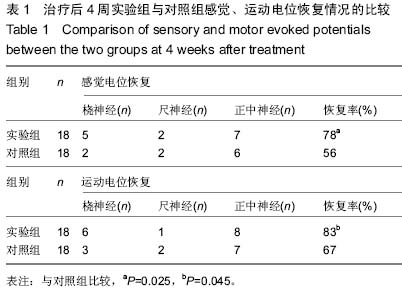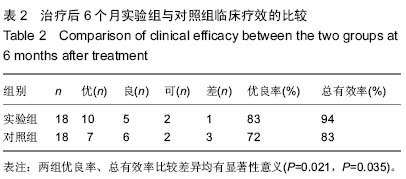| [1] Lundborg G.Neveregenerationandrepair:areview.ActaOrthop Scand.1987;58:145.
[2] Longo FM, Varon S,Manthorpe M.Neurite promoting factors and extracellalar matrix component s accumlating in vivo with in nerve regenerationChambers.Brain Res.1984;309: 105.
[3] Hernandez-Morato I,Isseroff TF,Sharma S,et al.Differential expression of glial-derived neurotrophic factor in rat laryngeal muscles during reinnervation. Laryngoscope.2014;124(12): 2750-2756.
[4] Hoyng SA,De Winter F,Gnavi S, et al. A comparative morphological, electrophysiological and functional analysis of axon regeneration through peripheral nerve autografts genetically modified to overexpress BDNF, CNTF, GDNF, NGF, NT3 or VEGF.Exp Neurol. 2014;261:578-593.
[5] Lykissas MG,Batistatou AK,CharalabopoulosKA,et al.The role of neurotrophins in axonal growth, guidance, and regeneration. CurrNeurovasc Res.2007;4(2):143-151.
[6] Hollowell JP,Villadiego A,Rich KM.Sciatic nerve regeneration across gaps within silicone chambers: long-term effects of NGF and consideration of axonal branching.Exp Neurol.1990; 110(1): 45-51.
[7] McTigue DM,Horner PJ,Stokes BT,et al.Neurotrophin-3 and brain-derived neurotrophic factor induce oligodendrocyte proliferation and myelination of regenerating axons in the contused adult rat spinal cord.J Neurosci.1998;18(14): 5354-5365.
[8] Yin X,Dong L,Wei W,et al.Effect of mouse nerve growth factor on the expression of glial fibrillary acidic protein in hippocampus of neonatal rats with hypoxic-ischemic brain damage.Exp Ther Med.2013;5(2):419-422.
[9] 陈燕涛,何清,刘尚礼.神经生长因子治疗周围神经损伤的前瞻性研究[J].中华创伤骨科杂志,2006,8(8):744-746.
[10] Du BL,Zeng CG,Zhang W,et al.A comparative study of gelatin sponge scaffolds and PLGA scaffolds transplanted to completely transected spinal cord of rat.J Biomed Mater Res A.2014;102 (6):1715-1725.
[11] 周志鹏,刘乐平,诸葛启钏.可吸收明胶海绵负载大鼠神经干细胞的体外混合培养[J].中华显微外科,2012,35(4):285-288.
[12] 方怀玺,张明.地塞米松明胶海绵复合物预防硬脊膜外粘连:83例随访[J].中国组织工程研究与临床康复,2007,11(35):7084-5.
[13] Lundborg G,Rosen B,Dahlin L,et al.Tubular repair of the median or ulnar nerve in the human forearm: a 5-year follow-up.J Hand Surg Br.2004;29:100-107.
[14] Aberg M, Ljungbery C,Edin E,et al.Clinical evaluation of a resorbable wrap-around implant as an alternative to nerve repair: a prospective, assessor-blinded, randomised clinical study of sensory, motor and functional recovery after peripheral nerve repair.J Plast Reconstr Aesthet Surg.2009; 62:1503-1509.
[15] 王刚,范顺武,李强,等.神经生长因子梯度缓释系统促进周围神经再生的临床疗效观察[J].中华显微外科杂志,2013,36(6): 558-562.
[16] 崔丽英.简明肌电图学手册[M]. 北京:科学出版社,2006.
[17] 傅重洋,赵佳,曲巍.组织工程化神经修复周围神经创伤的应用[J].中国组织工程研究,2013,17(41):7335-7340.
[18] Marquardt LM,Sakiyama-Elbert SE.Engineering peripheral nerve repair.Curr Opin Biotechnol.2013;24(5):887-892.
[19] Gao Y, Wang X, Chen J, et al. The role of peripheral nerve ECM components in the tissue engineering nerve construction. Rev Nruiosci,2013:24(4):443-453.
[20] Talaverón R,Matarredona ER,Rosa R,et al.Neural progenitor cell implants modulate vascular endothelial growth factor and brain-derived neurotrophic factor expression in rat axotomized neurons.PloS One.2013;8(1):e54519.
[21] Aloe L.Rita Levi-Montalcini: the discovery of nerve growth factor and modern neurobiology.Trends Cell Biol.2004; 14(7): 395-399.
[22] Gravvanis AI,Tsoutsos DA,Tagaris GA,et al.Beneficial effect of nerve growth factor-7S on peripheral nerve regeneration through inside-out vein grafts: an experimental study. Microsurgery.2004;24(5):408-415.
[23] Menorca RM,Fussell TS,ElfarJC.Nerve physiology:mechanisms of injury and recovery.Hand Clin.2013; 29(3): 317-330.
[24] 郑湘予,文建国,王福建,等.不同给药途径生长因子对坐骨神经再生的影响[J].中华小儿外科杂志,2013,34(7):539-542.
[25] 陈庆真,施明祥,刘盛飞.鼠神经生长因子不同给药方式修复周围神经损伤.中国组织工程研究,2014,18(33):5356-5360.
[26] Zhang H,Wu F,Kong X,et al.Nerve growth factor improves functional recovery by inhibiting endoplasmic reticulum stress-induced neuronal apoptosis in rats with spinal cord injury.J Transl Med.2014;12:130.
[27] Aloe L, Bianchi P, De Bellis A.Intranasal nerve growth factor bypasses the blood-brain barrier and affects spinal cord neurons in spinal cord injury.Neural Regen Res. 2014;9(10):1025-1030.
[28] Yu H,Liu J,Ma J,et al.Local delivery of controlled released nerve growth factor promotes sciatic nerve regeneration after crush injury.Neurosci Lett.2014;566:177-181.
[29] Wong AW, K P Yeung J,Payne SC,et al.Neurite outgrowth in normal and injured primary sensory neurons reveals different regulation by nerve growth factor (NGF) and artemin.Mol Cell Neurosci.2015;65:125-134.
[30] 吴俊,周贤刚.神经生长因子对周围性面神经炎的循证治疗[J].循证医学,2006,6(6):344-347.
[31] 于肇英.神经生长因子的研究[J].生理科学进展,1988,19(3): 226-230.
[32] Granholm AC,Albeck D,Bäckman C,et al.A non-invasive system for delivering neural growth factors across the blood-brain barrier: A review. Rev Neurosci.1998;9(1):31-56.
[33] Kanda T.Blood-nerve barrier and peripheral nerve regeneration.Rinsho Shinkeigaku. 2013;53(11):1120-1122.
[34] UboguEE.The molecular and biophysical characterization of the human blood-nerve barrier: current concepts.J Vasc Res. 2013;50(4):289-303.
[35] Lai BQ,Wang JM,Ling EA,et al.Graft of a tissue-engineered neural scaffold serves as a promising strategy to restore myelination after rat spinal cord transection.Stem Cells Dev. 2014;23(8):910-21.
[36] Zhang K,Liu Z,Li G,et al.Electro-acupuncture promotes the survival and differentiation of transplanted bone marrow mesenchymal stem cells pre-induced with neurotrophin-3 and retinoic acid in gelatin sponge scaffold after rat spinal cord transection.Stem Cell Rev.2014;10(4):612-625.
[37] Du BL,Zeng X,Ma YH,et al.Graft of the gelatin sponge scaffold containing genetically-modified neural stem cells promotes cell differentiation, axon regeneration, and functional recovery in rat with spinal cord transection.J Biomed Mater Res A.2015;103(4): 1533-1545.
[38] Tsai CC,Lu MC,Chen YS,et al.Locally administered nerve growth factor suppressesginsenoside Rb1-enhanced peripheral nerve regeneration.Am J Chin Med. 2003;31(5): 665-673.
[39] Yoshimura K,Harii K.A regenerative change during muscle adaptation to denervation in rats.J Surg Res.1999;81(2): 139-146.
[40] 赵磊,严志强,吕广明.失神经支配骨骼肌的萎缩机制[J].中国组织工程研究与临床康复, 2007,11(6):1120-1122. |


.jpg)